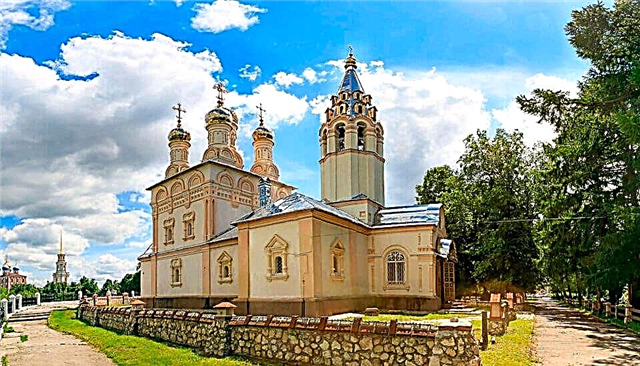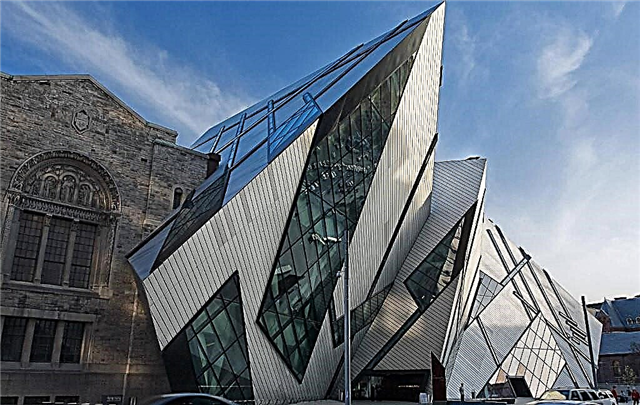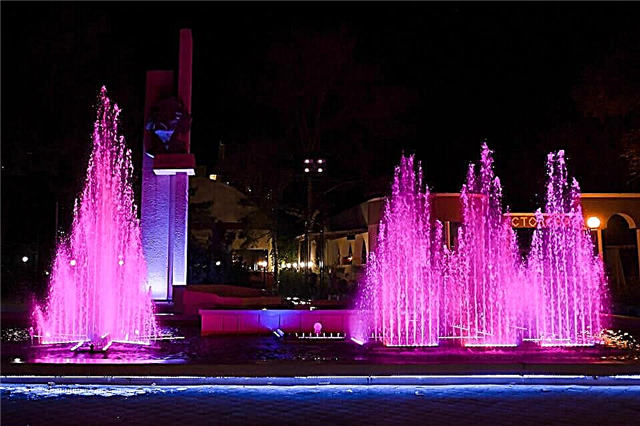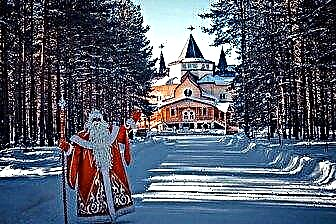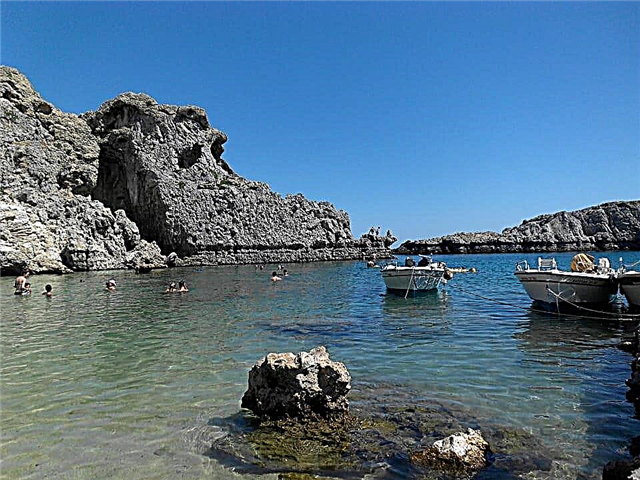The name of the island and the city located on its territory are synonymous with sea travel and carefree relaxation. Many consider this place to be an earthly paradise. There is only one amendment: almost the entire territory of Greece is an earthquake-prone zone.
If we add that the island has constantly become a territory of large-scale hostilities, the picture, from the point of view of logic, is sad. Rhodes' unique landmarks have often been destroyed. The fact that many natural monuments and architectural masterpieces have survived is comparable to a miracle. Previously, its indigenous population survived through livestock and agriculture, today the main source of income is tourism.
However, the Greeks are philosophical about such a change in activities, they continue to plant vineyards, orchards, breed goats, sheep, cows, arguing adherence to ancient traditions with their concern for tomorrow.
Rhodes fortress
The medieval building impresses with its power. 600 years ago, according to historians, it was the most impregnable fortress on the territory of Christian states. It was erected by the Hospitallers, whose military-religious order then owned the island. The organization, created during the time of the Crusades, is still active today. It is best known as the Order of Malta.
Hospitallers today do not wage wars, knights and ladies organize charitable medical, educational, scientific, cultural programs in all corners of the planet and ... have a tremendous influence on world politics. In the Middle Ages, the leadership of the order was located in the fortress. The building has been sieged several times. Muslims conquered it in the 16th century - 70 years after the fall of Constantinople.
The reason for the defeat of the defenders of the fortress was not even the numerical advantage of the opponents (a 100-thousandth army was thrown against several hundred knights), but the betrayal of the crowned persons who enjoyed the support of the order and were afraid of its strengthening. A significant part of the ancient defensive fortress structures have survived to this day. After extensive work in the last century, restorers managed to return the fortress to its original appearance.
Medieval town of Rhodes

By the decision of the three ancient states of the island (Kamiros, Ialyssos, Lindos), a new capital of the unified island state, the city of Rhodes, appeared. Additionally, it acquired the status of an important military base based along the coast of the sea. The event took place in the antique period of 408 BC. A memory of the times is information about the Colossus of Rhodes, a lighthouse included in the list of seven wonders. The history of the medieval city is filled with knightly raids, wars of the Ottoman army, and the victory of Italian soldiers.
The mixture of eras, traditions, customs of different nationalities has left an invaluable historical mark in the form of ancient buildings that have become important landmarks. Many monuments have been carefully restored by the Italians. They gave the city an unusual flavor, preserved to the descendants the memory of the events that raged in antiquity. Each street, the walls of a small private house are saturated with the atmosphere of antiquity.
Street of the Knights

In ancient times, this street was the home (residence) of the famous "languages" or representatives of different orders of Rhodes. It was their labor that a fortress was erected to protect the city. At the end of the old street, there is a building that served as a Byzantine church, the Catholic Church of the Virgin of the Fortress, and a mosque. For tourists of interest are the Archaeological, Byzantine museums located along the street. In several rooms of the Archaeological Museum are kept artifacts reflecting the life of the knights (the official name is "Order of St. John").
John the Baptist is the patron saint of the city. The fortress, built by knights, surrounded the medieval city (its length is 4 km.). Through its center was the street of Ippoton or Knights. Now it has an external image the same as in those days when the steps of a passing detachment of knights in armor and old clothes were heard on it (tourists see them). It is easy to find it, having reached the ancient fortress.
We recommend unusual excursions:
- Around the island - cognitive acquaintance with history and traditions (€ 60 per person)
- Day trip to Symi island - take a boat ride, wander around the city in pastel colors and taste Simi shrimp (€ 30 per person)
- Boat trip on a sailing yacht - conquer the Mediterranean Sea and spend the day on cozy beaches and picturesque bays (€ 80 per person)
- Picnic in the mountains and a walk in nature reserves - Valley of the Butterflies, an ostrich farm, a family picnic and a photo session in a picturesque village (€ 230 per group)
- Along the bays on a boat - relax body and soul on a beautiful journey with a Greek lunch (€ 50 per person)
- A trip to Marmaris - a one-day voyage on a ship - enjoy the seascapes, take a walk in a modern Turkish resort and do plenty of shopping (€ 35 per person)
- Sea Fishing and BBQ - Go fishing in the Mediterranean waters and prepare a delicious lunch from it (€ 85 per person)
Mandraki port

For over 2,500 years, Mandraki Port has been considered the main harbor. Now life has not stopped: hundreds of fishing boats, modern yachts, small cruise ships moor here all year round. All of them, as thousands of years ago, are greeted by bronze statues of a deer, deer, fortified on massive stone columns. Deer are recognized as a symbol of the city (according to legend, they saved the island from snakes by trampling them with their feet). According to an old legend, the famous monument Colossus of Rhodes (the sun god Helios) was located on the site of the statues. It was visible from other islands in the Aegean Sea.
An earthquake destroyed the statue in 222 BC. Three surviving medieval mills, reminiscent of the times of the knights, attract attention with their red roofs and stone turrets. At first there were 13 of them (the mills were destroyed by the Ottoman troops). They ground the grain arriving at the port. Mandraki port belongs to the historical part of the city, adjacent to the Fortress.
Fort St. Nicholas
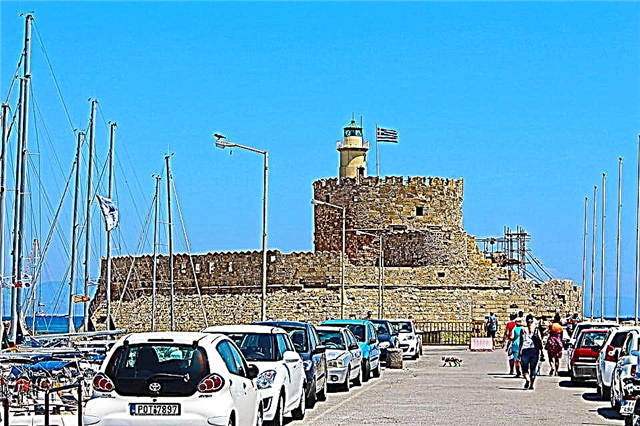
The imposing fort building was built to protect the port, harbor. It is located at the end of a 400 m pier, built in the antique period. It separates the harbor and the open sea. Preserved stone mills and the border fortress of St. Nicholas. Before the destruction of almost all the mills by the Ottomans, it was called the fortress of the mills. A round tower made of natural stone (its diameter is about 17 m) served as the first protection of the entrance to the harbor. It was built under the rule of the Grand Master Pierre Raymond in 1465 on the foundations of an old Byzantine church of sailors. Fortifications still perform important security functions today.
For example, there is a site with a lighthouse on the roof of the old tower of the Fort of St. Nicholas. He is shown in numerous photographs. For sailors, this is an important navigational element, helping to see the beautiful ancient shores of the legendary island in time. It is easy to get to the fortress of St. Nicholas by car, passing the port of Mandraki.
Acropolis of Lindos

The breath of the ancient powerful city, which was part of the Dorian Hexagon (Hexapolis), flourishing under the reign of the famous sage Cleobulus, can be felt by looking at the preserved ruins of the Acropolis. It is located on a hill 116 m high. Archaeological excavations have shown that there was also a temple erected on the site of an even more ancient structure. The rungs of the stairs at the foot of the hill are said to belong to this temple. Ancient city-states always had several levels.At the very top, the sanctuaries of the patron gods were erected.
The Acropolis of Lindos was popular during the ancient times of the island's life. The theater appeared on the southwestern part of the BC hill. NS. As an ancient sanctuary depicting the ancient Greek ship of trimiolia, the theater was carved into the rock. Now you can see several rows of spectators made of stone steps. There are many legends about the Acropolis of Lindos. According to one version, before the important march to the East, Alexander the Great was here. The ticket price to the Acropolis is 6 €. Opening hours vary depending on the season of the year.
Rhodes Acropolis

The ancient ruins of the Acropolis are located three kilometers from the city center, on top of Mount Smith. A unique view of the Old, New City opens from its top. Excavation of the hill began in 1912 and now only a small part of the ancient treasures is available to tourists. This is the famous complex of the ruins of the Temple of Apollo the Pythia, an amphitheater, where he studied the art of the orator Cicero. Marble odeon (theater), fully restored and has 800 seats. On the bottom row, three steps from the antique period have been preserved.
The theater now hosts musical performances. A stadium from the Roman period has been preserved next to the theater. Previously, Alionov sports competitions were held here. Now at the stadium, athletes are engaged, training is underway. Partially excavated are the temple of Athena and Zeus, nymphea (underground structures in the rocks), the sanctuary of Artemis. The Acropolis did not function as a fortification. There are no fortresses, stone guard towers.
Rhodes stadium

It is hard to believe that such a large-scale structure was erected by human hands! The huge cyclopean quadrangular stone in the stadium evokes thoughts of giant mythical creatures. The construction of the sports facility dates back to the 3rd century BC. It was specially created for the ancient Olympic Games. The acoustics of the building can be envied by modern concert venues: the word quietly spoken here is perfectly heard at a distance of 300-400 meters.
The stadium has perfectly preserved stands, stone benches (with backs) for spectators, and running tracks. Near the building in ancient times there was a temple of Apollo - the god of light, the patron saint of soothsayers, doctors, people of art. Gloomy buildings were also located not far from the stadium: the tombs where the nobles were buried, the altars of Hades - the rulers of the underworld of the dead. Ruins and 3 columns remained from the temple, the burials were much better preserved (they were relatively recently discovered during excavations).
Ancient Kamiros

A city from a lost kingdom, forever hidden by a thick layer of a devastating earthquake 22,000 years ago. He hid his secrets until the middle of the 19th century. The main excavations of the city began at the beginning of the 20th century. They allowed us to see the ruins of a Dorian temple that existed in the 3rd century BC. For the first time, the ruins of the city, the cemetery, temples on the top of the hill, the market, the acropolis were discovered in 1859. They belonged to one of the most developed, richest cities in the Dorian Six-Grade states.
Interesting facts are considered the found minted coin depicting a fig (totem of fertility), storage of drinking water, aqueducts for its supply to the population. The main path up the hill leads to the Acropolis, to the place where the temple of the goddess Athena towered. The ruins of the city are open on three levels, and the whole territory is at 120 m above sea level. At the top, there is an observation deck that offers a view of the ruins, the city, the sea.
Mount Filerimos

A path lined with cypresses leads to the majestic cross standing at the top. This road is called "The Way to Golgotha". Its length is equal to the path that Jesus traveled. Stone steles are installed along the road, reflecting scenes of the Lord's torment. You can get to the top by an internal spiral staircase. It is narrow, it is difficult for two travelers to disperse on it. A cross (at first wooden, and now stone) was installed by the monks living in the monastery. In ancient times, a small, but very important, famous city of Yalis flourished on the mountain.
Now the settlement is reminded of the ruins of the temples of Zeus, Athens, the monastery, the cell of St. George with preserved frescoes. The name of the mountain comes from the name of a hermit monk who settled here in the 1st century. It is said that the secret of the famous Filerimos liqueur was invented here. You can buy it only here in the shop of the descendants of the Greek family who have preserved it. Filerimos Nature Reserve is open every day except Mondays.
Tsambika monastery

The monastery (also called Panagia Tsambika) houses the icon of the Virgin Mary, the greatest religious shrine. The miraculous power of the icon has helped childless couples more than once. The number of pilgrims to her does not decrease over time. There are two monasteries with the same name: the lower (Kato) and the upper (Moni). The miraculous icon is located in the first one, built of snow-white stone with a bell tower. An interesting Orthodox museum and souvenir shops are located nearby.
A staircase with 300 steps leads to the second temple. It contains a copy of the icon. The original is brought up here annually on September 8 on the birthday of the Mother of God. The temple is located near the city of Archangelos. You can get there by bus, then on foot. The entrance to the temples is free.
Church of Our Lady of Lindos

The small town, called the pearl of the island, boasts the most beautiful Church of the Virgin. It was erected in the 13th century on the site of the foundation of a religious building in the center of a medieval city. Externally, the church is a cross-domed, snow-white temple with an octagonal dome, a Byzantine roof made of red tiles.
The cozy courtyard is paved with white and black pebble mosaics. The carved wooden iconostasis of the 17th century is considered the main decoration of the church. On the walls there are ancient frescoes depicting scenes from the life of Jesus, the Mother of God, and the holy apostles. The church is open daily. Admission free of charge, but wearing appropriate clothing.
Church of Saint Nektarios in Filiraki

A beautiful terracotta temple with columns was erected in honor of Nektarios helping a seriously ill person. This saint was the first to be canonized in modern times in Greece. One of the largest buildings in the resort village was erected in 1976. Inside there is an icon of St.Nektarios. According to Greek customs, it is decorated with metal embossing depicting parts of the human body (the tradition of asking for help during an illness). There are two churches on the island, built in honor of Nectarios.
One of them is located by the road leading from the village of Filiraki to the capital (next to the building of the main shopping center). It contains parts of the saint's relics. The green area in front of the church is decorated with a platform lined with mosaics of colored pebbles. There are benches for resting numerous pilgrims. You can enter the church for free.
Church of St. Panteleimon in Xi'an

In a small village popular with tourists in a hurry to buy honey, oil, and local crafts, there are two churches of St. Panteleimon. One of them is old (built in the 15th century). It was made of large boulders, without a bell tower with a cross on the roof. The new temple, erected in honor of St. Panteleimon (a healer revered in Greece) is small, but very elegant. The lace-like elements of woven white circles give it a solemn, festive look.
The church has two towers with painted clocks. There is a huge image of Jesus Christ on the bath. The interior decoration of the church glitters with gilding, frescoes, icons, murals telling about the life of the holy Martyr Panteleimon. Parts of his relics are also kept here. The easiest way to get to Xian with a tourist excursion is by bus, taxi. The entrance to the church is free.
Archaeological Museum of Rhodes

On the old street of the Knights (directly on the knight's alley), in a medieval building belonging to the hospital of the knights, there are numerous exhibits of an interesting museum. In the halls where aristocrats used to be treated, archaeological finds from different parts of the island are collected. Among them, the main place belongs to statues, ceramics, amphorae, jewelry. Here you can see the statue of Helios (patron saint of Rhodes), created in the 2nd century BC. A statue of Aphrodite of Rhodes kneeling and wringing out wet hair (it was made in the 1st century BC) from marble.
There is a hall dedicated to the life of the knights. There are many statues in the inner courtyard of the church. Here is the famous statue of a lion who put his paws on the head of a bull. It is made of special black granite. Open from 8 am to 7 pm.
Monolithos castle

The basis for the medieval castle-fortress is an impregnable rock. The structure, erected at an altitude of 250 meters above sea level, was built at the end of the 16th century. Historians find it difficult to say what happened here earlier, while mystics consider the rock to be one of the places of power.
The structure has been functioning for 30 years. When the Hospitallers left the island, the Muslims did not spend their strength and money on maintaining the fortress. It began to collapse, part of its walls turned into piles of cameos, but they, the remains of towers, colonnades, castle staircases, still look impressive today.
On the territory of the fortress there is a functioning temple of St. Panteleimon the healer - the heavenly patron of doctors and soldiers. Even during the fighting, services were not interrupted in this church. Its interior and exterior decoration has practically not changed over the past centuries, and, unfortunately, only a fragment of the wall remained from the luxurious chapel located in the fortress.
Kritinia castle

The building belonged to the Hospitallers. It differs from similar castles on the island in more graceful architecture, which reflects the Italian and Greek medieval canons. The construction of the main part of the fortress was completed in the second half of the 15th century. For a hundred years, the Knights of Malta have made changes to the layout of Kritinia, increasing the defenses of the structure. Each of the 3 levels of the castle was autonomous and could, independently of its other parts, reflect the attacks of the invaders.
When the fortress ceased to belong to the Hospitallers, it quickly fell into disrepair. Local authorities were never able to organize its restoration. Only powerful outer walls and dilapidated towers remained of the magnificent structure. The castle housed the Church of St. Paul, but the temple suffered a similar fate.
Numerous tourists strive to get to this amazing place to admire nature, plunge into the atmosphere of antiquity, knightly romance. The castle is located between the villages of Kamiros Skala and Kritinia, 50 km from Rhodes. The road is narrow here, tourist buses do not pass. You can get there by car or scooter.
Rodini park

3 km on the road leading to Lindos, there is a landscape creation of the world, made in antiquity. At the time of the knights, the territory was home to a Palace that belonged to the Grand Masters. The park occupies the territory of a small valley, decorated with oleanders, plane trees, beautiful flowers, babbling streams of rivers, and a mirror-like surface of ponds. Openwork bridges run over a garden of blooming water lilies. Peacocks roam freely among the magnificent plants. The park has a waterfall, a small zoo with important deer that have become a symbol of Rhodes.
The park has preserved and operates an ancient water supply system. Above the Park, you can see the ruins of an ancient necropolis with tombs carved into the rock (Ptolemy's tomb). The ancient Park was given the status of a tourist attraction. It is open all year round, admission is free.
You can get here by bus # 3.
Kallithea Springs Baths

The region of Kallithea is the oldest site on the island, belonging to the city-state of Ialyssos. Numerous churches with amazing frescoes, residential buildings remind of the Byzantine period of life. The main attraction of the town was considered to be the famous baths, a hydropathic spa on healing springs, erected during the reign of Mussolini. The baths destroyed by the war have been completely restored. Now it is beautiful, cozy here among the snow-white columns, mosaics, beautiful arches, sea of flowers in cool healing waters.
The Baths of Kallithea have been completely restored. The sandy beach completes the list of pleasures offered in the ancient baths. The Kalithea Springs Museum contains documents describing the stages of restoration of the baths. A nature reserve with a museum, thermal baths located between Kallithea and Faliraki.
Seven sources

The unusual place, created by nature over the centuries, is considered a popular tourist attraction on the island. A powerful underground spring comes to the surface in seven places, forming beautiful streams of the purest water falling from the rocks. The stream enters the Lutanis River, then rushes through a man-made concrete tunnel into an artificial lake. This is the only body of water (Kolimbei region) filled with fresh water.
Local legends say that if you go through a dark, 200-meter tunnel leading to the lake, you can cleanse yourself of the seven deadly sins. People walking barefoot in the very cold water of the tunnel receive a lifelong indulgence. There are not many who wish, but to lie on the shore of the azure lake, to breathe in the wonderful aroma of conifers, there are much more rare flowers. You need to get here by car, using the detailed signs of Epta Piges.
Cape Prasonisi
Translated from Greek, the name of the natural monument means: "green island". It is connected with Rhodes by a sandy isthmus. The cape, where the lighthouse built at the end of the 19th century is located, is simultaneously washed by 2 seas: Cretan and Libyan. The first is part of the Aegean Sea, the second is the Mediterranean. The name "Libyan" does not exist on modern geographical maps - this is how the sea was called in ancient times.
On the territory of Prasonisi, the Knights of the Order of Malta at one time erected a fortress tower. She and 15 more of the same structures constituted the defensive and signal Rhodes system at the same time. However, civilization existed here long before the appearance of the Hospitallers (and probably functioned in the 1st millennium BC). Today the cape is famous for its beach; about 300 people permanently live in its settlements.
On the cape there are services for renting water equipment, boats, schools for teaching beginners in water sports. A bus goes to the cape twice a day. The duration of the ride is 3 hours. If you rent a car, then the choice must be made on an SUV.
Valley of the Butterflies
It is also called the Petaloudes Valley (after the name of the municipality). This is a narrow park, located along the gorge and going up to the top of the hill. Thousands of different butterflies live here. Nature has created an unusual microclimate in the valley, formed by small rivulets, subtropical plants, and styrax-like trees emitting odorous resins (they have been used in perfumery for the manufacture of incense for many hundreds of years). Their delicate aroma attracts butterflies from the bear family. Variegated butterflies are visible only at the time of flight. At the beginning of the dry season, all butterflies of the island gather in the valley.
Among them is the Bear Mountain butterfly, listed in the Red Book. In order not to disrupt the life of rare creatures, special wooden paths have been made for tourists in important places. Against the background of an extraordinary natural panorama, you can see the ancient monastery of the 17th century, erected in honor of the Virgin Mary Cleopatra, the ancient (from ancient times) bench of Tiberius (the exiled emperor).
Agnos Pavlos bay

It seems that this place was created for lovers of quiet relaxation, yoga, diving.Wild coast, strewn with stones, sand, covered with rocks, crystal clear water in the bay. Yoga fans from all over the world gather in the extraordinary silence, completely calm place with strong energy. There is a modern yoga center here. It is also a diving kingdom. Lovers admire the extraordinary underwater beauty of the bay. The bay is located near the Acropolis of Lindos.
The beach is just a walk away. Local legend says that the ship of the Apostle Paul stopped in this bay in 58 AD. On the edge of the beach area of the bay, a small snow-white church was erected in honor of the holy Orthodox preacher Paul. In it residents of the nearest settlements and Lindos get married.
Anthony Quinn Bay

There is a sandy and pebble beach known far beyond the Mediterranean. Basically, young people rest in the bay - lovers of family vacations choose quieter places. The history of the attraction is a vivid example of how a big name and an emergency on film set can bring world fame to an ordinary, albeit very picturesque, bay. It is named after the popular actor, whose list of awards includes an Oscar and other (no less significant for the art world) awards.
There are many versions of the history of the bay's renaming. Today it is already difficult to say which of them is closest to the truth. US citizen Anthony Quinn was indeed the owner of the bay. However, at the moment the natural monument and the beach belong to the state. The paradox is that Quinn (100% Mexican by birth) contributed a unique treasure to the popularization of Greek dance culture by pure chance!
Folk dance "Sirtaki" never existed. It was created in the 60s of the last century from different choreographic elements to save the most important scene of the film "The Greek Zorba". The actor broke his leg on the eve of filming, could not move quickly, and as a result he got ... a new dance, which has become a symbol of Greece.
Water park in Faliraki

The main entertainment center of the island is Faliraki. In the central part of the town there are many entertainment establishments such as nightclubs, casinos, restaurants, taverns, discos. Vacationing youth will definitely come here during their vacation. Since 2001, the water park, Luna Park, began to work. The territory of the water park is divided into three zones.
The first contains extreme water slides of various types. The second area is dedicated to a large pool with artificial waves. In the third, kids of any age can tinker. They are provided with safe slides, a variety of attractions. At the service of vacationers are provided a jacuzzi, massage rooms, a shopping center for shopping. A taxi ride from the main airport to Faliraki costs 30 €.
Monastery of the Archangel Michael
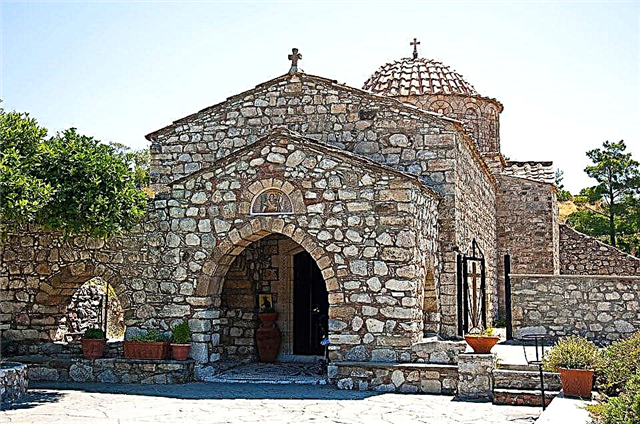
The Greeks call the monastery "Farri" in honor of the leader of the heavenly host. In translation, the word means: "it seems." It was pronounced, according to legend, by Michael to the princess, who recovered in Rhodes and donated huge funds for the construction of the monastery. According to another version: so spoke the crowned person who threw a precious ring on the ground in order to build a temple where he stopped. The servants searched for a long time, where is the decoration, and said in response to the questions of the hostess: "Farri!"
She so tortured her subjects with her orders that they began to see the ring everywhere. According to local mystics: the monastery is located in a place of power. They argue that in ancient times there was a temple of Apollo, where pilgrims came from all over Greece in the hope of healing. The first Christian structure on the site of Farry, as it turned out, was built 1,500 years ago.
Fragments of this basilica, including the mosaic floor, have survived as elements of a later building. The monastery of the Archangel Michael has never been plundered in its history. In his church, you can still see the original frescoes of the 12th century, a unique (saved thanks to restoration) iconostasis. In Farry, where Christians from all over the world come in the hope of finding healing and peace of mind, several monks live today.
Traganu beach

Rhodes Town and the beach are separated by 20 kilometers. There is not a huge number of tourists, noisy crowds of tourists. Tragana is chosen by those who prefer romance and silence. There are no hotels, hotels, shops, restaurants near the beach. The only thing: there is a tavern on its territory, which serves local fish dishes prepared according to old recipes. Part of the beach is closed to civilians - only the military rest on this site.
Traganu's main attraction: the caves. One of them is located entirely on land, the other is partly in the underwater kingdom. The sea water on this part of the coast is cooler due to the presence of cold springs. The beach has basic facilities, but the number of sun loungers is very limited. The latter, I must say, is not a critical moment, since Traganau is poorly populated and beautiful with its pristine beauty, not distorted by the dubious benefits of civilization.
Tsambika beach

Tsambika Beach (Tsambika) is often called the most beautiful beach in Rhodes. The recreational area is located at the foot of the mountain of the same name. Not far from Tsambik, there is a monastery whose history has given its names to the mountain and the beach. The Greeks used the word "tsambika" for a fiery spark. Church legends say: the poor shepherd noticed sparks on the mountain, approached them and saw the miraculous icon of the Virgin Mary. The relic is still kept in the monastery, where pilgrims come from all over the world.
The beach has the necessary amenities, but Tsambika differs in a certain severity from typical places of mass recreation. There are no entertainment facilities here. Cafes, taverns, retail outlets look modest and very cozy. Beach length: 800 meters. He is beautiful at any time of the day. Its important advantages: warm sea water compared to neighboring beaches and very clean sand.
Lindos beach

Distance between the beach and the city of Rhodes: 50 kilometers. Lindos is located in a shallow bay. This place is most often chosen by those who are vacationing with children. Once upon a time there was an ancient city of the same name. Not far from the beach you can see the remains of temples, palaces that belonged to the ancient Greeks and Romans. In the Middle Ages, churches, chapels and monasteries were built on elevated areas along the coast.
Today Lindos is a very small city, whose main value is natural and architectural monuments, an authentic carefree atmosphere, craft workshops where original souvenirs are made from wood, clay, shells and other natural materials. The easiest way to get to the cozy beach of the same name is from the central city square, from where a street leads to the sea. Not far from the popular recreation area there are shops, entertainment venues, cafes, taverns, restaurants, conditions for a comfortable pastime of tourists have been created.
Jewish quarter

The history of the Greek Jewish communities dates back to antiquity. In the Middle Ages, national quarters arose for a very commonplace reason: it was easier to survive this way. The Jews fled to Rhodes from Spain not in search of a better life - they fled from the fires of the Inquisition. New Greek subjects equipped streets, erected buildings, opened synagogues, trade shops, and educational institutions.
And then in the city everything happened again. Only there was nowhere to run from the block. In the 20s of the last century 4000 Jews lived here, in 1944 - 42. Local authorities extradited the inhabitants of the quarter to the Nazis - for extermination in Auschwitz. A Muslim Turkish consul stood up for the surviving Jews at the risk of his own life.
Nowadays, on the site of the quarter, there is a square where a monument to the dead is erected.A part of the architectural complex is a synagogue built in the 16th century (the other five were destroyed during the war); there is a museum of the Jewish community in it. Among the famous sights of the quarter: the Palace of Admirals, built in the 15th century, and the reconstructed Seahorse fountain.

